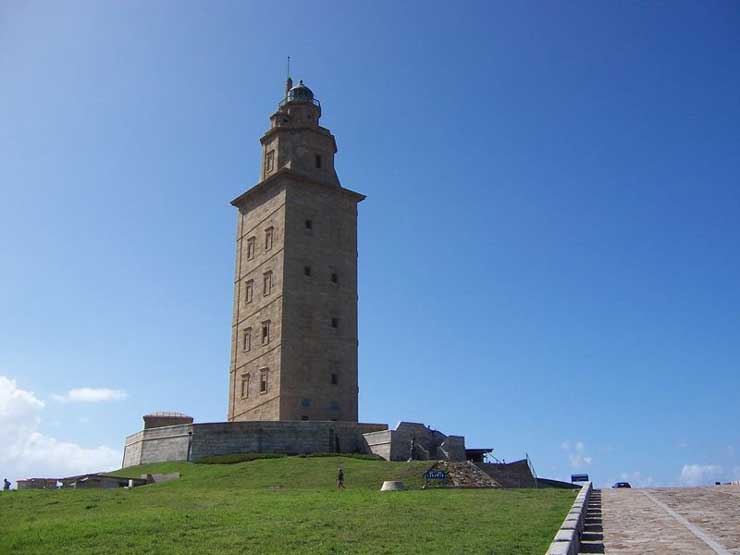.

Tower of Hercules (Source)
The Tower of Hercules (Torre de Hércules), is an ancient Roman lighthouse located on a peninsula about 1.5 miles (2.4 kilometers) outside the city of A Coruña, Galicia, in present-day northwestern Spain. The lighthouse is almost 1900 years old, standing 185 feet (57 meters) high, overlooking the North Atlantic coast of Spain. It is the oldest active Roman lighthouse in the world.
Through the millennia many mythical stories of its origin have been told. According to a myth that blends Celtic and Greco-Roman elements, the hero Hercules slew the giant tyrant Geryon after three days and three nights of continuous battle. Hercules then—in a Celtic gesture— buried the head of Geryon with his weapons and ordered that a city be built on the site. The city, Brigantia to the Romans, came to be called “Crunya”. The lighthouse atop a skull and crossbones representing the buried head of Hercules’ slain enemy appears in the coat-of-arms of A Coruña.
According to Gaelic legend embodied in the 11th-century compilation Lebor Gabala Erren— the "Book of Conquests"— King Breogán, the founding father of the Galician Celtic nation, constructed here a massive tower of such a grand height that his sons could see a distant green shore from its top. The glimpse of that distant green land lured them to sail north to Ireland. A colossal statue of Breogán has been erected near the Tower.
Historically, the tower is known to have existed by the 2nd century, built or perhaps rebuilt under Trajan, perhaps on foundations and just possibly following a design that was Phoenician in origin. At its base is preserved the cornerstone with the inscription MARTI AUG.SACR C.SEVIVS LUPUS ARCHTECTUS AEMINIENSIS LVSITANVS.EX.VO, permitting the original lighthouse tower to be ascribed to the architect Gaius Sevius Lupus, from Aeminia (an ancient Roman town near present-day Coimbra, Portugal) in the former province of Lusitania, as an ex voto dedicated to Mars. The tower has been in constant use since the 2nd century. Originally it was constructed with an ascending ramp encircling its sides, for oxen to bring cartloads of wood to keep the light fueled at night.
The earliest surviving mention of the lighthouse at Brigantium is by Paulus Orosius in Historiae adversum Paganos written ca 415 – 417:
“Secundus angulus circium intendit, ubi Brigantia Gallaeciae civitas sita altissimum farum et inter pauca memorandi operis ad speculam Britanniae erigit”
("At the second angle of the circuit [circumnavigating Hispania], where the Gallaecian city of Brigantia is sited, a very tall lighthouse is erected among a few commemorative works, for looking towards Britannia.")
The Tower of Hercules, in the coat of arms of La CoruñaIn 1788 the original tower was provided with a new outer shell by order of king Carlos IV, the work of the naval engineer Eustaquio Giannini (1750–1814). The work was finished in 1791, giving the tower the crisp classicizing outward aspect we see today. Within, the much-repaired Roman and medieval masonry may be inspected. The Tower of Hercules is a National Monument of Spain.
Sitting on the Costa da Morte, the "Coast of Death", it remains a sentinel from days long past. The Romans who settled this region of Spain believed it to be the end of the earth as is indicated by the name of a location further to the south on the Atlantic coast, named "Finnisterra" literally meaning "end of the earth". This region was notorious for shipwrecks and is equipped with a small lighthouse.
A medieval watchtower in Segovia also bears the name "Tower of Hercules" [1].
References
- "Documentos para estudiar la Torre de Hércules" (in Spanish)
- AnnaMaria Mariotti, "The Hercules' Tower"
- Spain.info: Tower of Hercules
- (Universidade da Coruña) Torre de Hércules (in English)
| Ancient Greece
Science, Technology , Medicine , Warfare, , Biographies , Life , Cities/Places/Maps , Arts , Literature , Philosophy ,Olympics, Mythology , History , Images Medieval Greece / Byzantine Empire Science, Technology, Arts, , Warfare , Literature, Biographies, Icons, History Modern Greece Cities, Islands, Regions, Fauna/Flora ,Biographies , History , Warfare, Science/Technology, Literature, Music , Arts , Film/Actors , Sport , Fashion --- |
Retrieved from "http://en.wikipedia.org/"
All text is available under the terms of the GNU Free Documentation License

